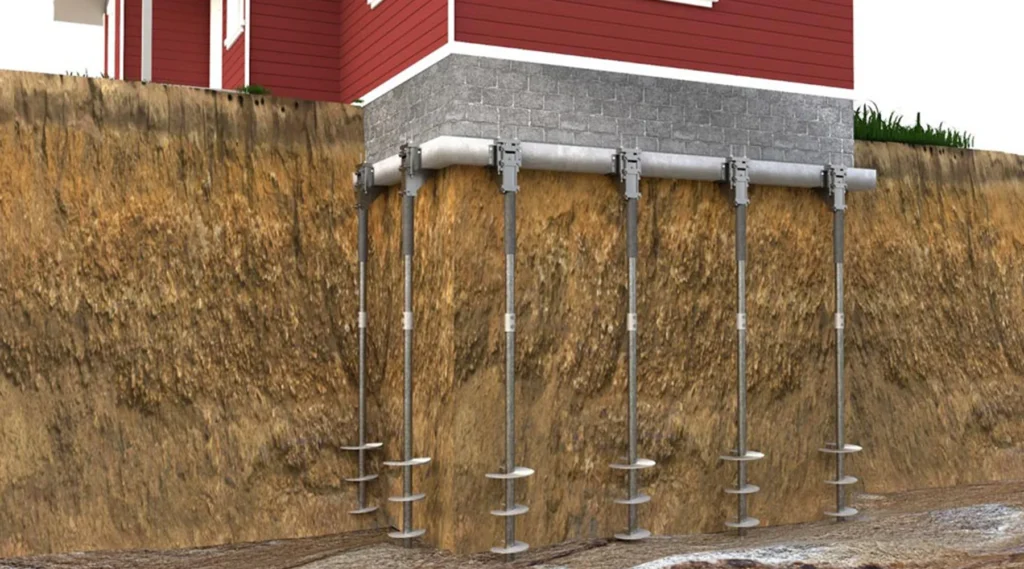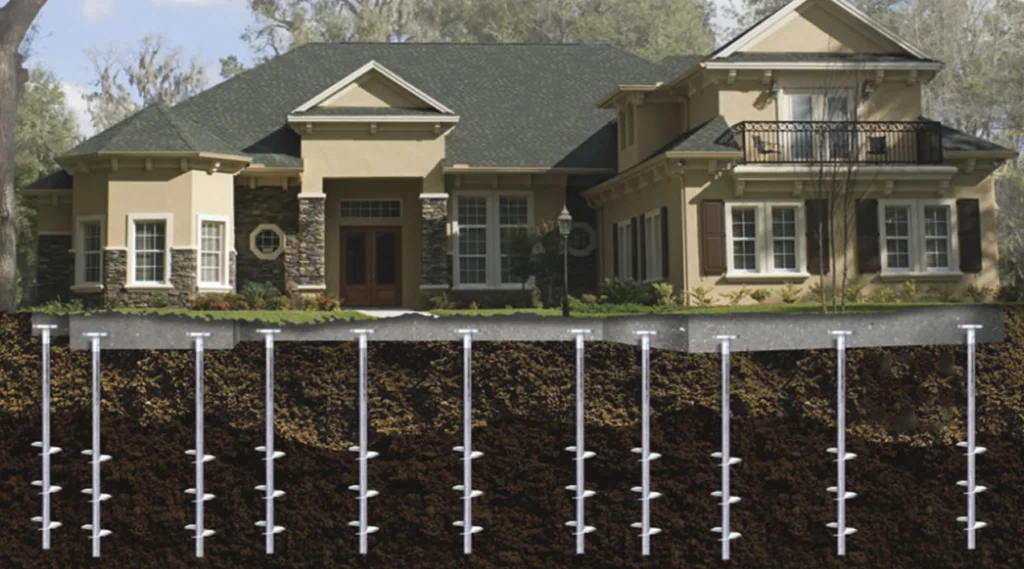Helical piers are built to last for decades—typically 75 years or more—when properly installed and used in the right soil conditions. Made from strong, corrosion-resistant steel, they offer a long-term solution for stabilizing foundations. Their durability makes them a trusted choice for both residential and commercial projects where long-lasting support is essential.
When facing foundation settlement issues, homeowners want solutions that will stand the test of time. Helical piers have emerged as one of the most reliable and long-lasting foundation repair methods available today. At Tri-State Waterproofing, we’ve been installing helical pier systems for over 23 years across Georgia, South Carolina, and North Carolina. This comprehensive guide will explore everything you need to know about helical pier lifespan, durability factors, warranty coverage, and what makes these foundation solutions so remarkably long-lasting.
What Are Helical Piers?
Helical piers, also known as screw piles, are steel foundation supports used to stabilize and strengthen structures built on weak or shifting soil. They look like large metal screws and are drilled into the ground until they reach stable soil. This gives your home or building solid support from below. Helical piers are commonly used for foundation repair, new construction, and to prevent further settling in homes with foundation issues.
Helical Pier Design and Function
Structure Components:
- Steel shaft: High-strength steel pipe or solid bar
- Helical plates: Spiral-shaped steel plates welded to the shaft
- Bracket system: Connects pier to foundation
- Load transfer mechanism: Distributes structural weight
How They Work: Helical piers are screwed deep into the ground until they reach stable, load-bearing soil or bedrock. The helical plates act like screws, providing both installation ease and exceptional holding power. Once installed, they transfer the weight of your structure from unstable surface soil to deeper, more stable ground.
Helical Pier Lifespan: The Numbers
Let’s have a look at the lifespan of helical piers:
- Minimum expected lifespan: 75 years
- Typical performance range: 75-100+ years
- Optimal conditions: 100+ years
- Manufacturer projections: Often exceed 150 years
Real-World Performance: Historical data from installations dating back to the early 1900s shows helical piers continuing to perform effectively after 100+ years of service. Many railroad and utility installations from the 1920s and 1930s remain structurally sound today.
Comparison to Other Foundation Solutions
Helical Piers vs. Alternatives:
- Concrete piers: 50-75 years typical lifespan
- Steel push piers: 75-100 years
- Underpinning: 25-50 years depending on method
- Slab jacking: 5-15 years temporary solution
Factors Affecting Helical Pier Durability
Here are the key factors that can impact how long helical piers last and perform over time.
1. Material Quality and Specifications
- Hot-dip galvanizing: Primary corrosion protection
- Steel grade: Typically ASTM A572 Grade 50 or higher
- Coating thickness: Minimum 3.9 mils (100 microns)
- Quality control: Manufacturing standards and testing
Galvanization Process: The hot-dip galvanizing process creates a metallurgical bond between zinc and steel, providing superior corrosion protection compared to painted or powder-coated alternatives.
2. Soil Conditions and Environment
Corrosive Soil Factors:
- pH levels: Acidic soils (pH < 5.5) increase corrosion risk
- Chloride content: High salt content accelerates corrosion
- Moisture levels: Consistently wet conditions affect longevity
- Electrical conductivity: High conductivity increases corrosion potential
Georgia Regional Considerations:
- Clay soils: Generally less corrosive, favorable for longevity
- Coastal areas: Higher salt content requires additional protection
- Industrial areas: Potential chemical contamination concerns
- Groundwater conditions: Seasonal variations and chemistry
3. Installation Quality
Critical Installation Factors:
- Proper torque application: Ensures adequate bearing capacity
- Depth to stable soil: Reaching appropriate load-bearing strata
- Bracket attachment: Secure connection to foundation
- Load testing: Verification of capacity before loading
Professional Installation Benefits: At Tri-State Waterproofing, our certified installers ensure:
- Proper equipment calibration
- Accurate torque monitoring
- Comprehensive load testing
- Quality documentation and reporting
4. Load Conditions and Structural Factors
Load Management:
- Design load capacity: Proper sizing for structural requirements
- Safety factors: Conservative design margins
- Load distribution: Even weight distribution across the pier system
- Future load considerations: Accounting for potential additions
Maintenance Requirements for Longevity of Helical Piers
You can follow the given things to increase the lifespan of the helical piers”
Routine Inspection and Monitoring
Annual Inspections Should Include:
- Visual bracket examination: Check for damage or movement
- Foundation monitoring: Look for new settlement signs
- Drainage assessment: Ensure proper water management
- Load condition review: Verify no unauthorized modifications
Professional Inspections: We recommend professional evaluation:
- Every 5 years: Comprehensive system assessment
- After major events: Earthquakes, floods, or severe weather
- Before property transfer: Pre-sale inspection and certification
- When issues arise: Immediate professional evaluation
Preventive Maintenance
Homeowner Responsibilities:
- Maintain proper drainage: Keep water away from foundation
- Monitor for changes: Watch for new cracks or settlement
- Protect exposed components: Prevent damage to visible brackets
- Document performance: Keep records of any observations
Professional Maintenance:
- Load testing: Periodic capacity verification
- Corrosion assessment: Evaluation of protective coatings
- System optimization: Adjustments for changing conditions
- Preventive treatments: Additional protection when needed
Signs of Helical Pier Issues
Watch for these common signs that may indicate problems with your helical piers.
Structural Signs:
- New foundation cracks: Indicating potential movement
- Door/window problems: Sticking or gaps developing
- Floor irregularities: New slopes or uneven areas
- Wall separations: Gaps at corners or joints
System-Specific Indicators:
- Bracket movement: Visible displacement or damage
- Corrosion signs: Rust staining or coating failure
- Load transfer issues: Uneven settlement patterns
- Drainage problems: Water accumulation around piers
When to Seek Professional Evaluation
Immediate Attention Required:
- Sudden or rapid settlement
- Visible pier or bracket damage
- Structural instability signs
- Water infiltration around piers
Routine Professional Assessment:
- Scheduled maintenance inspections
- Pre-purchase evaluations
- Insurance requirement compliance
- Long-term performance optimization
Choosing the Right Helical Pier System
Engineering Considerations:
- Load requirements: Proper capacity sizing
- Soil conditions: Appropriate design for site conditions
- Environmental factors: Corrosion protection needs
- Future requirements: Accommodation for potential changes
Quality Indicators:
- Manufacturer reputation: Established track record
- Material certifications: Quality assurance documentation
- Installation expertise: Qualified contractor selection
- Warranty coverage: Comprehensive protection terms
Working with Tri-State Waterproofing
Our Advantages:
- 23+ Years Experience: Proven installation expertise
- Quality Materials: Premium manufacturer partnerships
- Comprehensive Warranties: Full coverage protection
- Professional Installation: Certified, experienced crews
- Ongoing Support: Long-term relationship commitment
Service Process:
- Site evaluation: Comprehensive soil and structural assessment
- Custom design: Engineered solution for your specific needs
- Professional installation: Expert placement and testing
- Quality assurance: Thorough inspection and documentation
- Long-term support: Ongoing monitoring and maintenance
Conclusion
Helical piers represent one of the most durable and long-lasting foundation repair solutions available today. With proper installation, quality materials, and appropriate maintenance, these systems can provide 75-100+ years of reliable service, often outlasting the structures they support.
The key to maximizing helical pier lifespan lies in:
- Professional installation by experienced contractors
- Quality materials with proper corrosion protection
- Appropriate design for site-specific conditions
- Regular monitoring and preventive maintenance
- Prompt attention to any developing issues
At Tri-State Waterproofing, we’re committed to providing helical pier solutions that will protect your foundation for generations. Our combination of premium materials, expert installation, comprehensive warranties, and ongoing support ensures that your investment in helical piers will provide decades of reliable performance.
Ready to secure your foundation’s future with helical piers? Contact us today for your free comprehensive evaluation and learn how these remarkable foundation solutions can provide lasting stability for your home.


